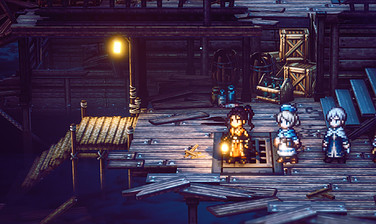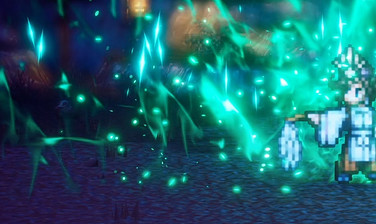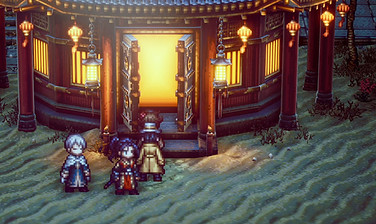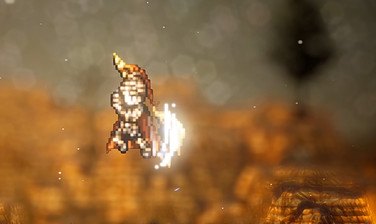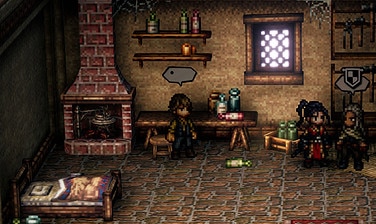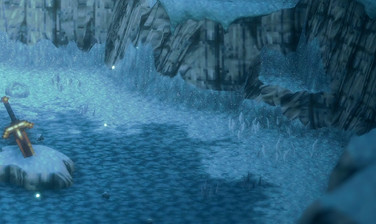This is an in-depth guide to the Dancer job in Octopath Traveler 2. We’ll break down the Dancer job including Skills and interaction with the other Jobs of Octopath Traveler 2.
 What is the Role of a Dancer
What is the Role of a Dancer
Dancers are primarily a supportive class, but can deal decent damage with both physical and magical attacks. They specialize in the use of Daggers as weapons, with a good mix of single-target and multi-target abilities.
Their supportive nature comes from their dancing skills, most of which provide various buffs to their allies. This includes boosting Physical Attack, Magic Attack, or even moving an ally’s action forward.
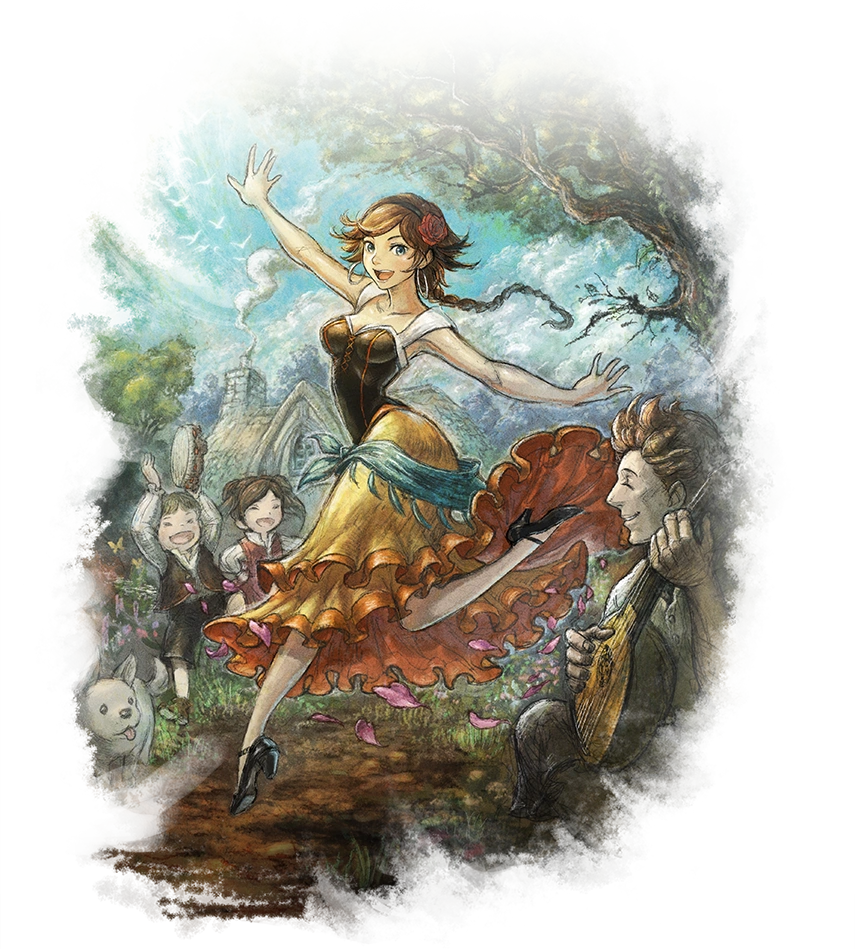
In Octopath Traveler 2, Agnea Bristarni has Dancer as her main role. Agnea is a dancer for a small village tavern but dreams of performing for larger crowds. She wishes to follow in her mother’s footsteps and become a star that brings smiles to people’s faces.
How Dancer Has Changed for Octopath Traveler 2
While the Dancer still retains their identity as a more supportive job, they’ve also gained more offensive options. They did lose a couple of buffs they had, but they’ve been moved to other jobs in some shape or form.
Dancer’s lost access to Mole Dance, which got moved to Cleric and combined with their old Sheltering Veil Skill. This means the Dancer no longer provides any defensive buffs, focusing more on an offensive kit.
The open slot left by Mole Dance was filled by Ruinious Kick, one of the Dancer’s new starter skills. I think losing a buff for a strong skill that ignores weaknesses and will always reduce Shield Points is a great substitution.
They no longer have Panther Dance, which effectively became the Thief’s new Swift Step Skill. This isn’t a huge loss, since Thieves can now boost their own speed. Additionally, Dancer was given Stimulate as means of manipulating turn order in a much more controlled manner.
Finally, Dancers have also lost access to multi-target Elemental Damage, but in its place gained access to a multi-target Dagger skill in Dagger Dance. This is a fairly good trade-off as There tend to be better Physical Damage daggers over Elemental Damage ones.
One of the biggest changes for Dancers though is their new set of Support Skills. Getting earlier access to Hard Worker is going to alleviate a lot of the endgame grind that the previous game. They also get a brand new Support Skill that makes them a much more interesting support option.
Dancer Skills: Overview and Recommendations
Like all classes, the Dancer has both Active Skills and Support Skills that can affect their combat ability. Below you can read the overview and recommendations for each skill individually, followed by a segment with recommendations on which skills to pick first and why!
Active Skills
Active Skills are skills used in battle, to either attack, provide buffs, or apply debuffs. Below are the Active Skills available to Dancers. Dancers have access to Lion Dance and Ruinous Kick by default, the other skills require the use of Job Points, or JP to unlock.
Among the Active Skills are Divine Skills, which are powerful skills that are unique to each class. These however cannot be unlocked until all other skills have been unlocked first, which requires a large amount of JP, in addition to their own unlock cost.
Lion Dance
- Skill Type:
Buff
- SP Cost: 4
- Effect: Increases the target’s Physical Attack for 3 turns
- Boost Effect: Extends the buff duration by 2 turns per BP spent.
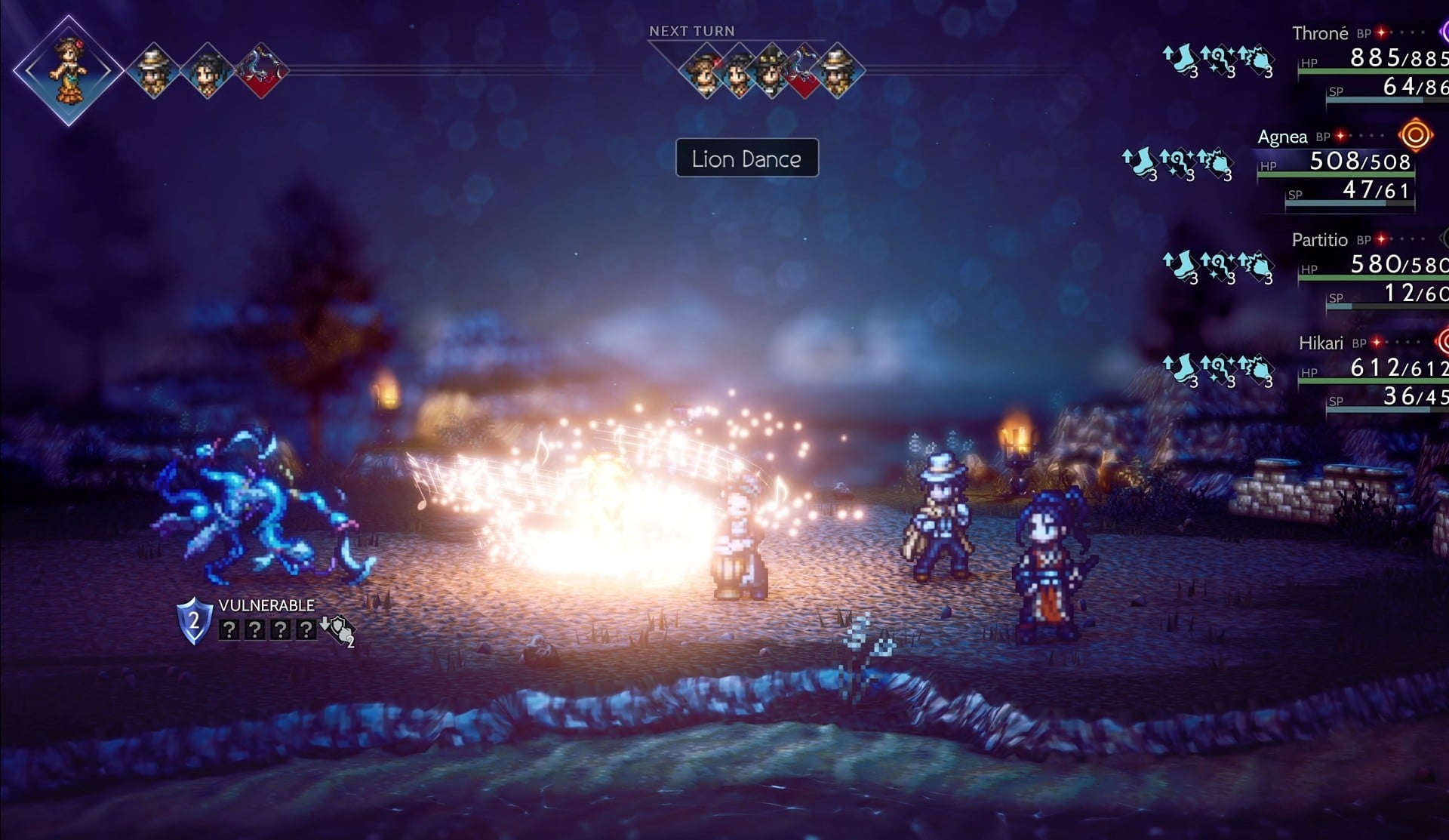
Lion Dance is a great self-buff to start with and becomes excellent party support later on. So long as an enemy does not have means to lower your physical damage, which ends this effect instantly, this can be very easy to maintain.
Ruinous Kick
- Skill Type: Physical
- SP Cost: 10
- Effect: Unleash a powerful physical attack on a single foe, reducing their shield points regardless of weaknesses.
- Boost Effect: Increases damage dealt per BP spent.
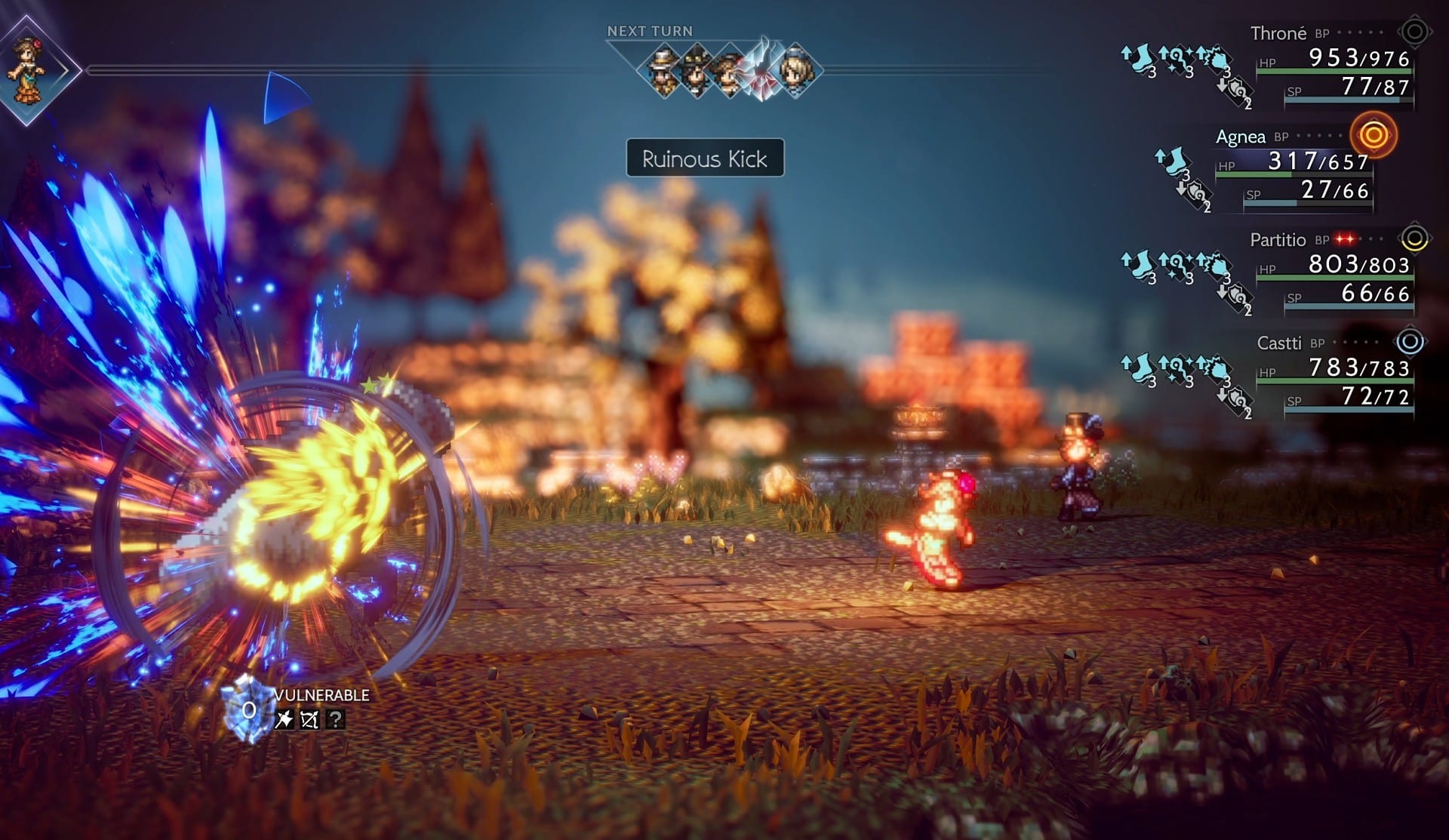
On it’s own it’s a very strong attack, dealing very high damage relative to what the Dancer can do otherwise. The ability to always take away a Shield Point from a foe and the ability to spread it with All Together Now makes this skill a force to be reckoned with.
Peacock Strut
- Skill Type: Buff
- SP Cost: 4
- Effect: Increases the target’s Magic Attack for 3 turns.
- Boost Effect: Extends buff duration by 2 turn per BP spent.
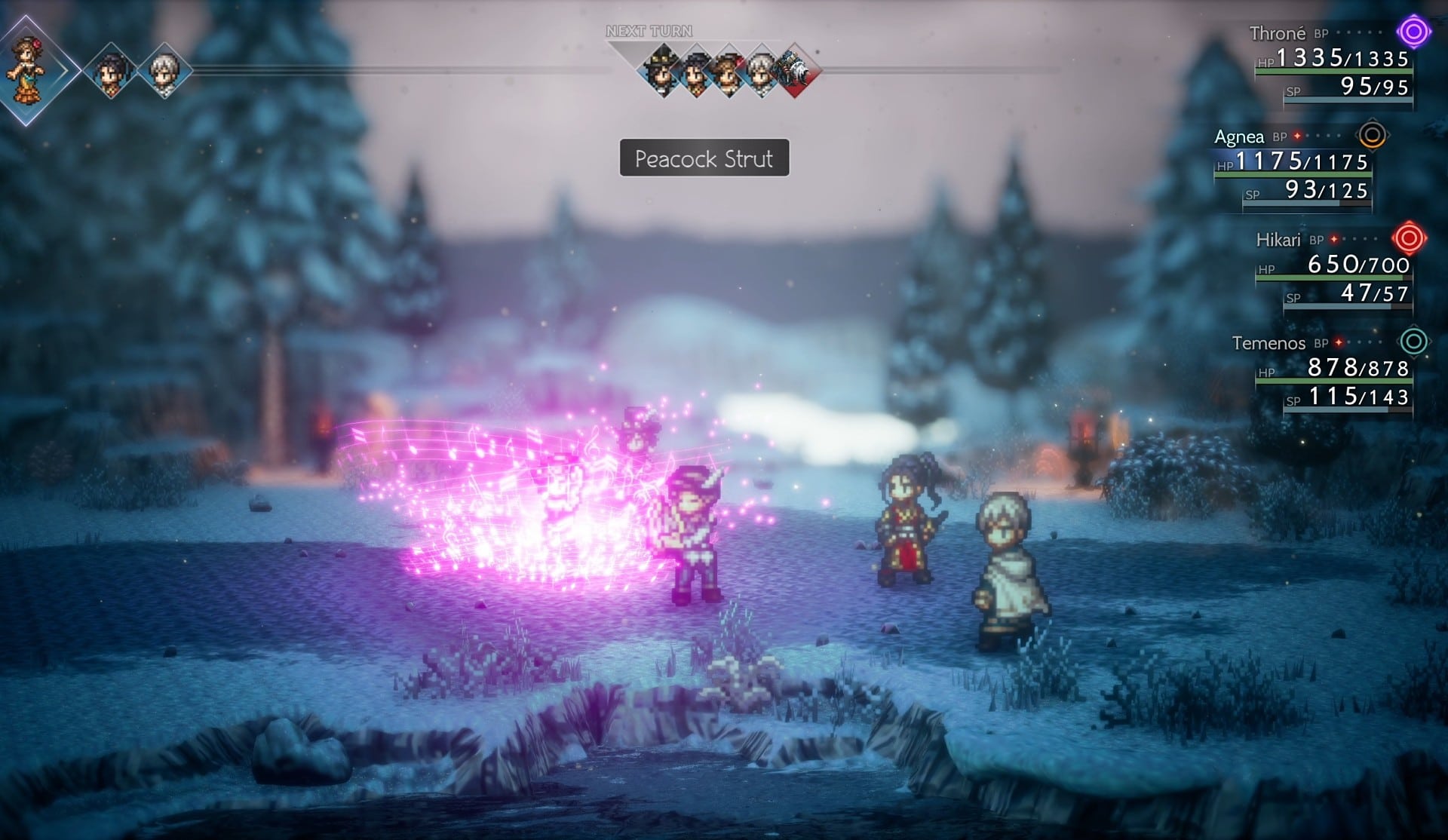
Peacock Strut is the Magic Attack equivalent of Lion Dance, which allows Dancers to support both types of attackers fairly well. Much like Lion dance, this effect can be removed by having your Magic Attack lowered by a foe.
Sweeping Gale
- Skill Type:
Wind
- SP Cost: 7
- Effect: Deals wind-based damage to a single foe
- Boost Effect: Increases damage per BP spent.
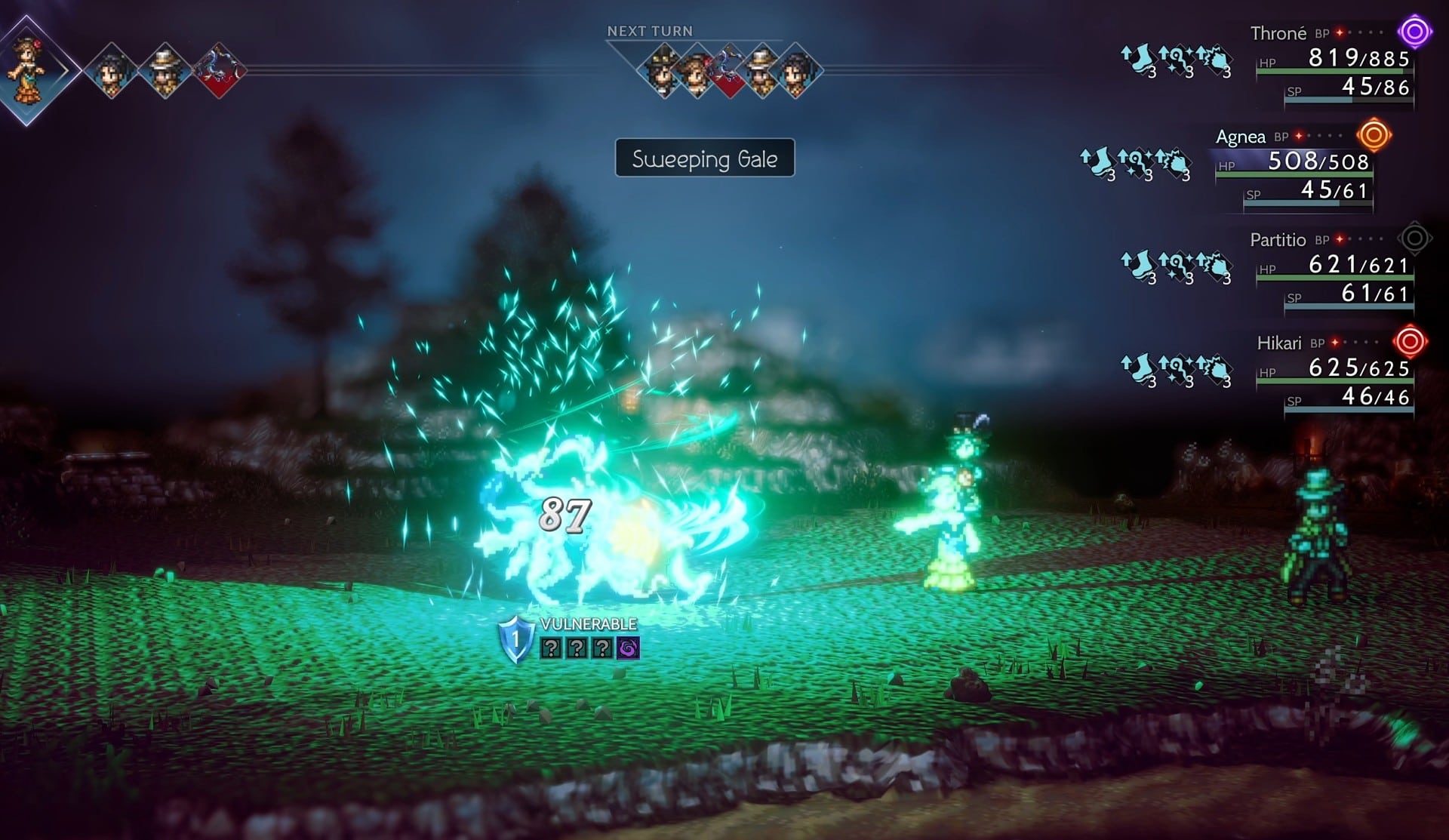
Being the Dancer’s only Magic option early on, it’s not too bad for dealing with flying enemies that are typically weak to it. It’s helped immensely by the ability to make it multi-target via All Together Now.
Stimulate
- Skill Type: Buff
- SP Cost: 5
- Effect: Move a single ally’s action 1 spot.
- Boost Effect: Increases the number of spots moved.
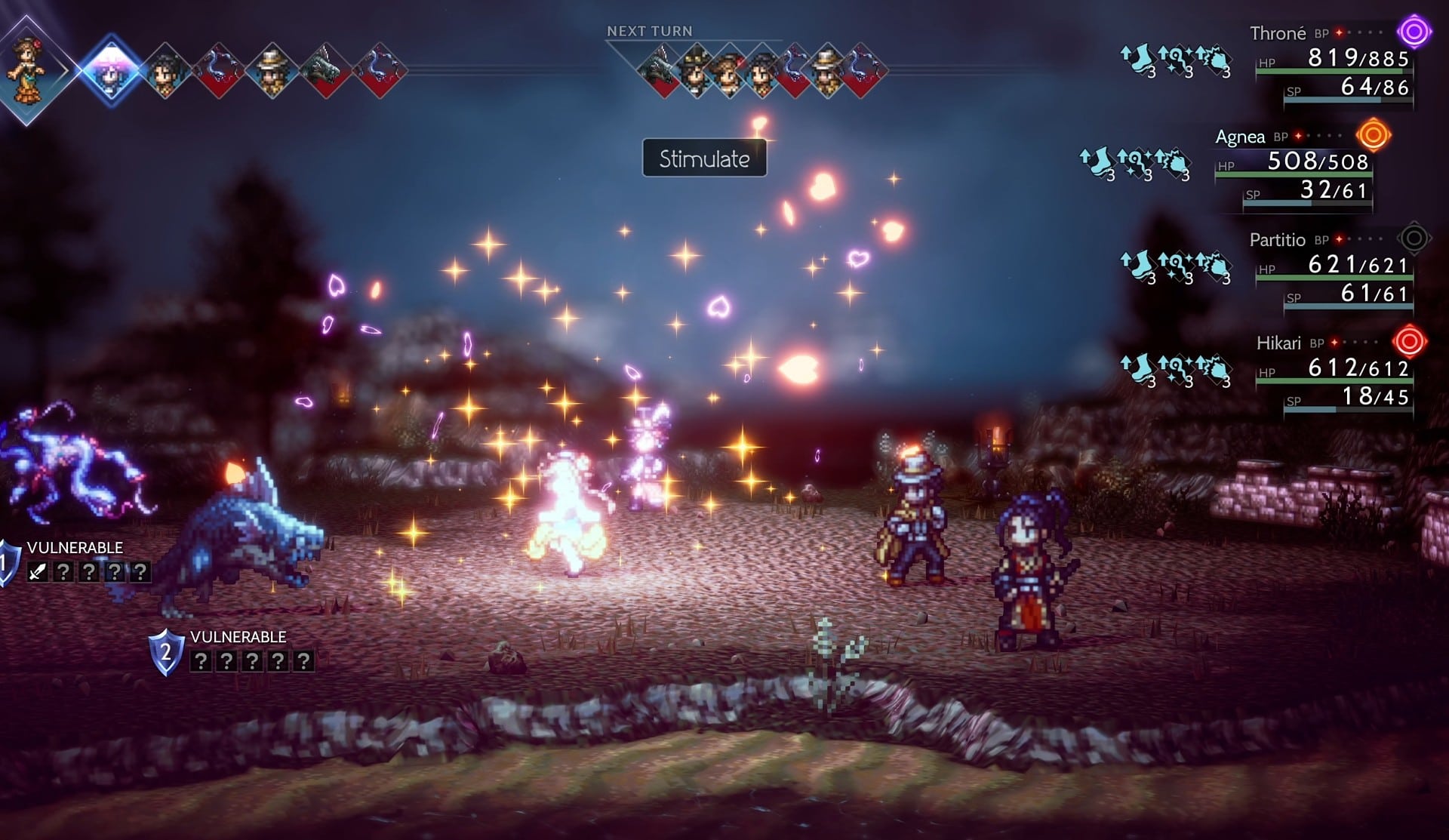
At face value, this skill can seem pretty disappointing or useless. However, it’s an effective form of manipulating turn order, making sure your strategies can work as intended more often.
Dagger Dance
- Skill Type:
Dagger
- SP Cost: 9
- Effect: Unleash a dagger attack on all foes.
- Boost Effect: Increases damage dealt per BP spent.
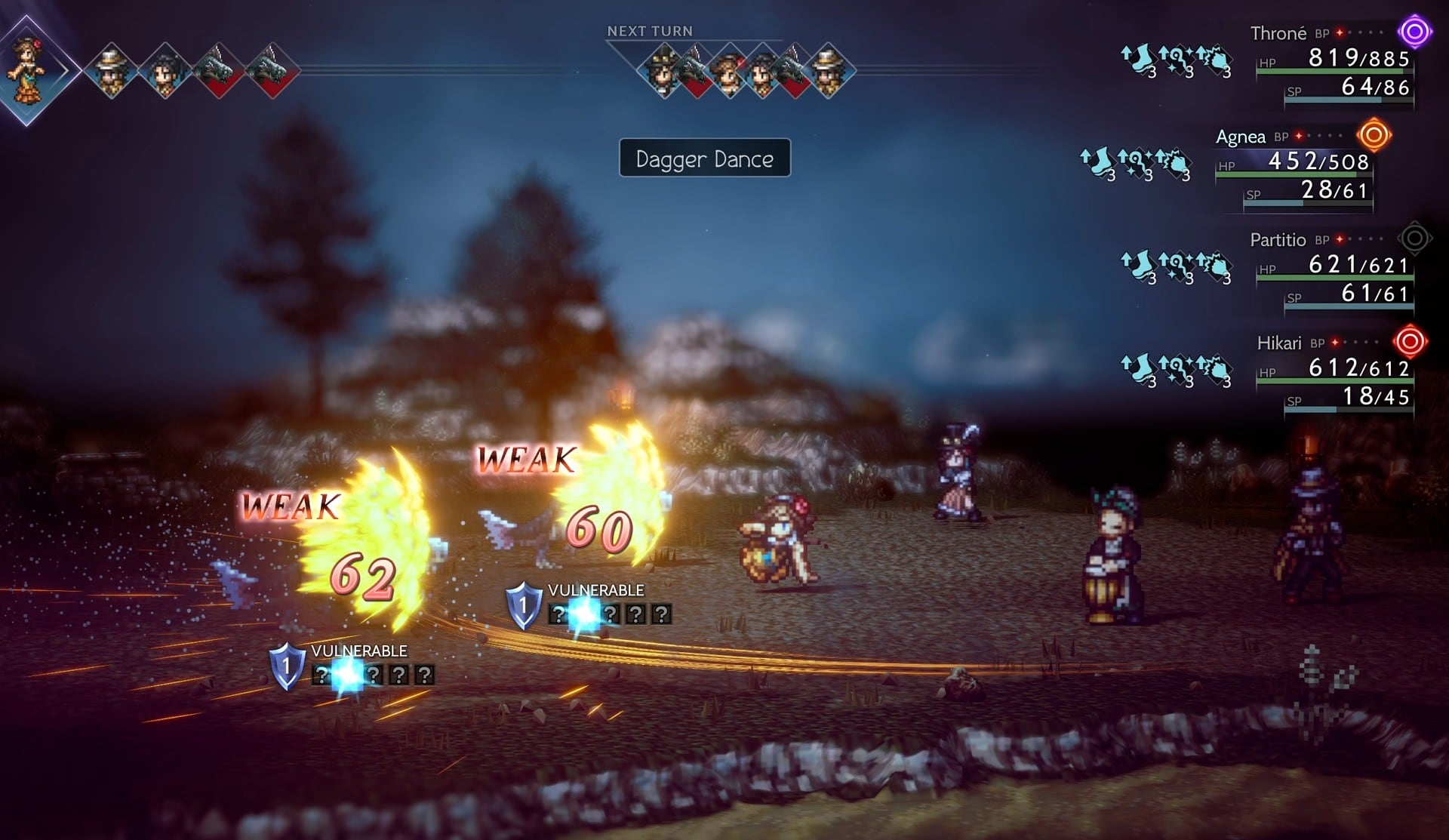
Dagger Dance is a great multi-target attack, but its real power comes from the fact that it benefits from your Dance Session talent. This can allow you to maintain HP, SP, or even some buffs very easily while not holding back on damage
Bewildering Grace
- Skill Type: Buff, Debuff, Acquisition
- SP Cost: 25
- Effect: Causes a curious effect to occur one time.
- Boost Effect: Increases the number of effects by 1 per BP spent. Boosting also increases the likelihood of stronger effects, both positive and negative, of occurring
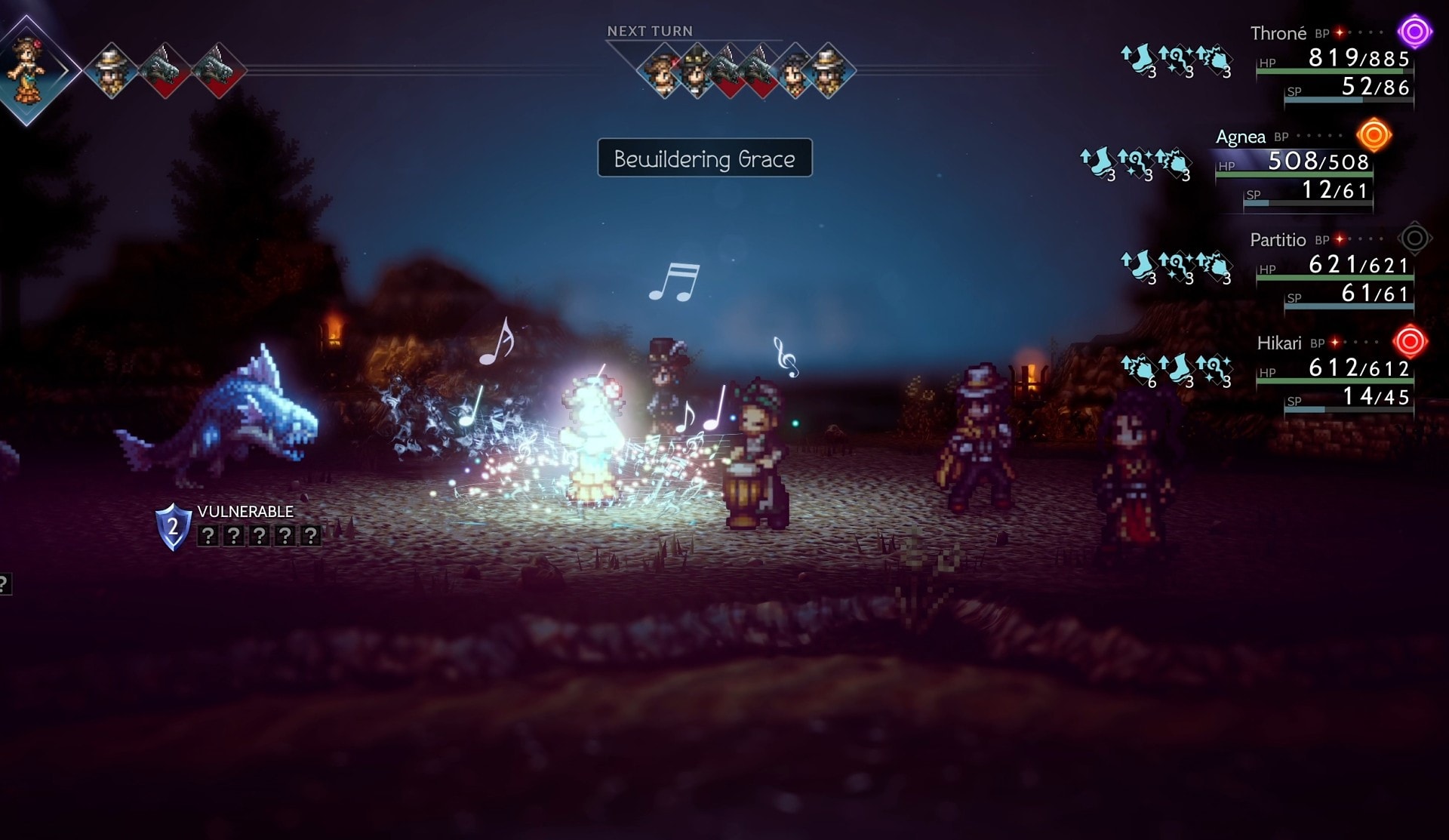
Bewildering Grace is very RNG heavy. While it has powerful effects like boosting the gain of EXP or JP, these are far from guaranteed. There are also incredibly dangerous negative effects this can inflict on your party, like reducing them to 1 HP. Thankfully in Octopath Traveler 2, the more painful effects seem limited to the caster
Divine Skill – Sealticge’s Seduction
- Skill Type: Buff
- Cost: 30 SP + 3 BP
- Effect: Makes a targeted ally’s single-target skills hit all targets instead for three turns. This cannot be applied to other Divine Skills.
- Boost Effect: Requires maximum boost to activate.
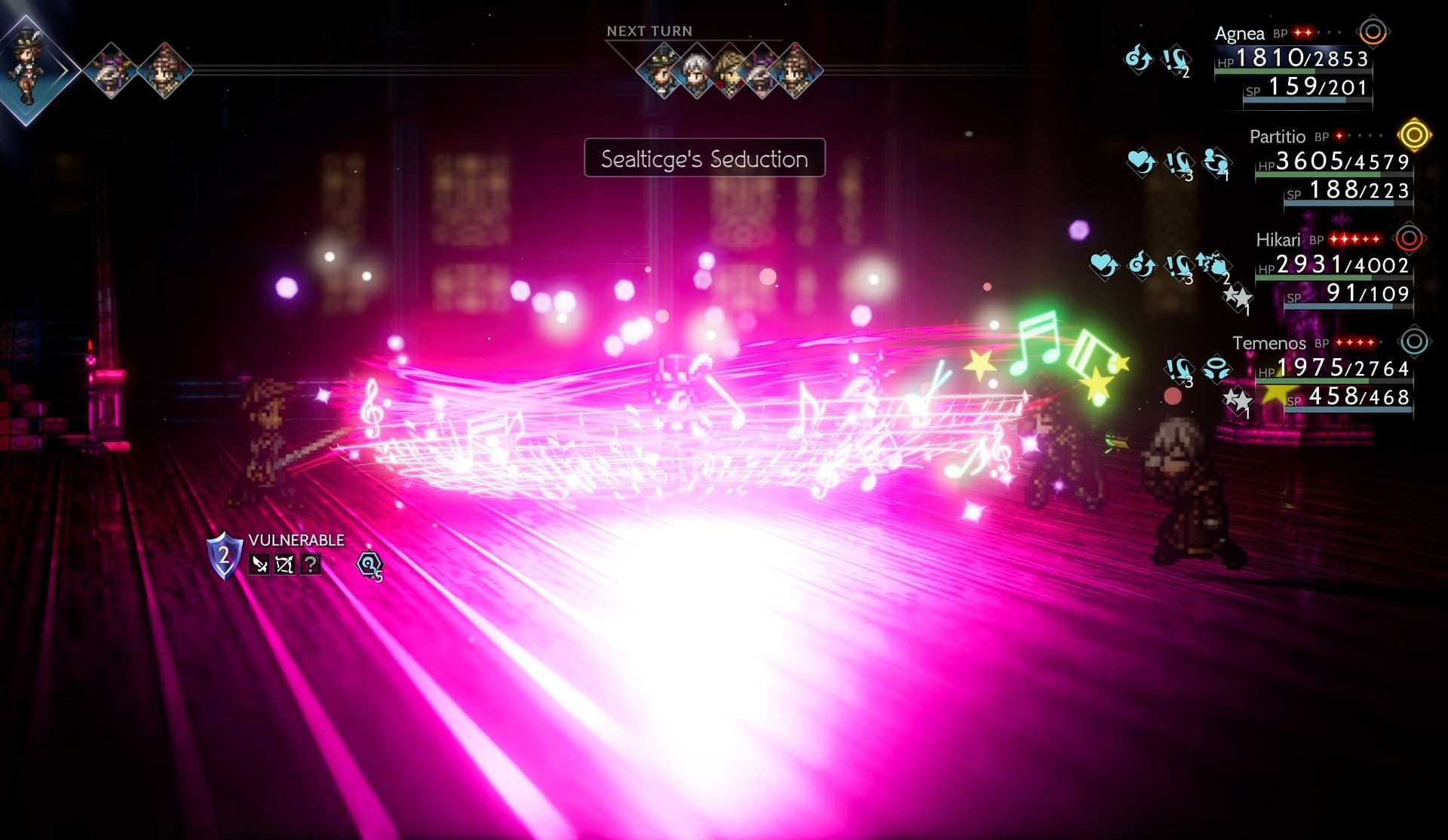
Sealticge’s Seduction is a great way to very quickly apply buffs to a party, including some very powerful options from other jobs. However, much like Agnea’s Latent Power, it cannot spread skills that affect only the caster. It also has strong synergy with many damage-dealing skills across the cast of jobs.
Which Dancer Skills you should take first
Since Active Skills can be taken in any order in Octopath Traveler 2, it’s worth considering the benefits of taking each skill. The cost for the next skill increases as you pick skills, so take the time to plan which skills you’d want to make sure you never feel weak.
Of the Dancer Skills, Dagger Dance is without a doubt the best skill to take first. This gives you a consistent multi-target option without relying on Agnea’s Latent Power, or a similar effect. It also has the additional benefit of being the only offensive skill that can trigger Agnea’s Dance Session Talent.
Once you pick up a character than can make better use of Elemental Attack, Peacock Strut should be a high priority. This allows the Dancer to improve the damage of your allies, regardless if they rely on Physical or Elemental Damage.
Stimulate is only good once you have a full party. Before then, there’s no point in picking it up early, as using it to manipulate turn order isn’t as impactful. It still has its uses of course, like guaranteeing an ally can move before a dangerous foe, but situations, where you’d want to do that, are rare.
While Bewildering Grace has some powerful supportive and damage effects, Bewildering Grace is a very low-priority skill. It’s not consistent enough to be worth an early pickup, in addition to consuming a ton of SP. The negative effects will often hurt you far more early than any of the positive effects can help.
Support Skills
Support Skills are passive bonuses that can be mixed and matched with Support Skills of other classes after unlocking them. Support Skills are unlocked alongside your Active Skills, being tied to the number of unlocked Active Skills for the class. These provide stat boosts or other combat effects entirely passively and do not need to be activated beyond applying them to a character.
The Show Goes On
- Total JP Cost: 130
- Effect: Extends the duration of buffs applied by the equipped character by 1 turn.
The Show Goes on fits really well with the general identity of the dancer. While not always the most practical way to extend buffs, it does help reduce the number of times buffs may need to be cast in an Encounter.
Ever Evasive
- Total JP Cost: 630
- Effect: Increases equipped character’s ability to evade attacks.
This is a fairly strong defensive Support Skill for character that are lacking bulk. While Evasion itself isn’t reliable, this does help considerably with mitigating physical attacks.
Hard Worker
- Total JP Cost: 1630
- Effect: Increases the amount of JP obtained from battles. (Equipping multiple with this Support Skill will not provide a stronger effect.
This Support Skill is absolutely essential for grinding out JP to unlock Support Skills for your party. This effect grants a 50% increase, making it quite effective. Since it stacks with similar effects from other sources, it remains useful through normal gameplay.
This effect stacks additively with effects from Bewildering Grace or the Thief’s Life in the Shadows Support Skill. This would mean a battle that would normally grants 100, would grant 150 and if Bewildering Grace activates it’s double JP effect, you’ll gain 250 JP instead of 300.
Invigorate and Inspire
- Total JP Cost: 4630
- Effect: Slightly fills the target’s Latent Power gauge when the equipped character grants them an augmenting effect.
This Support Skill, alongside Agnea’s Talent, Dance Session, allows this passive to very quickly fill the Latent Power gauge for herself and her allies. Combined with the Dancer’s Divine skill, this can allow the Dancer to be an even more powerful support.
Dancer Job Synergies
Below you will learn which secondary Jobs best complete the Dancer as a starting Job and how the Dancer Job synergizes and performs best as a secondary job with other starting jobs!
 How Agnea Synergizes with Other Jobs
How Agnea Synergizes with Other Jobs
Due to Agnea’s own Latent Power, All Together Now, she can work well with any battle job that provides additional single-target buffs or attacks. Despite being more Physical-oriented, this can make Scholar a great battle job due to their new, unique buffs.
You could also opt for Merchant as well to make use of All Together Now. This allows her to generate extra JP through Arrow of Fortune. This can help her to further support JP gains beyond just the Hard Worker Support Skill.
Warrior can be an extremely powerful option for a more offensive pairing. Both Agnea’s Latent Power as well as Sealticge’s Seduction can make Aggressive Slash hit all foes, which makes it an extremely powerful and effective way of breaking foes.
For encounters where there are many buffs being applied, the same can also apply to Enervating Slash. This will strip all foes of their positive effects and deal heavy damage. It may also scale the damage of the hit on all foes for each buff removed from individual targets, but more likely they take damage respective to the buffs removed.
This can also apply to Hunter‘s Precise Shot skill, effectively creating the Rain of Arrows skill the Hunter had in the first Octopath Traveler. Though instead of a random number of hits, the number of hits would be determined by the amount of BP used.
On the supportive side of things, the Apothecary is an excellent battle job for Agnea. This is because the Healing Touch skill can simultaneously revive fallen allies and heal those alive. Additionally, you can apply the effect of Replenish Health to your whole party, letting them recover health over time.
Cleric is also a great option if you really want to boost the defense of your party. between Prayer to the Flame boosting both Physical and Magic Defense as well as Sacred Shield halving the damage of hits. Mystical Staff can also be used to maintain SP between casts of buffs.
Considering advanced jobs, Agnea is exceptionally good as an Inventor, as well as supporting another character with the job. This is again due to her Latent Power and the Dancer’s Divine Skill. Being able to spread the effects of both Arkar’s Coil and Elemental Bomb Bottle can be incredibly strong.
She’s also an exceptional Arcanist as well. Not only does the job grant her additional magic that’s a mix of offense and support, but she’s also able to spread the effects of Reflective Barrier. This can result in your party being entirely immune to Elemental damage.
While not the best pairing, she can also make effective use of Armsmaster as well, providing many of the same benefits to the job as she does for the Warrior. This means multiple strong attacks that are able to hit multiple foes, giving a ton of breaking potential.
Check out our Agnea Character Guide to learn about this character and their unique actions within the game. You can also check out our Walkthrough of their story, for hidden items in their story and boss strategies.
 How Dancer Synergizes with Other Jobs
How Dancer Synergizes with Other Jobs
Agnea aside, the Dancer can work well as a battle job when paired with a job that expands their ability to apply buffs or support their allies. Most classes are able to provide this to some degree, with the exception of Warrior and
Merchant who only have self-cast buffs.
Dancer could very easily be used as a battle job for other jobs that lack an innate ability to increase their damage as well. This can allow them to use Lion Dance or Peacock Strut as a means of self-buffing, without having to rely on any other effects or other party members.
Outside of the buffs and additional Dagger and Wind coverage for damage type, the Dancer can leave a lot to be desired as a battle job. It’s by no means weak but will require a good bit of support to work well. Its main selling point is the Divine Skill, Sealticge’s Seduction, which has many strong synergies with multiple jobs, many of which are shared with her Latent Power, as detailed previously.
This concludes our in-depth Job Guide for the Dancer.

 Buff
Buff Wind
Wind How Agnea Synergizes with Other Jobs
How Agnea Synergizes with Other Jobs